| View previous topic :: View next topic |
| Author |
Message |
Roger Warin

Joined: 23 Jan 2013
Posts: 1233



|
 Posted: Nov 23, 2019 09:22 Post subject: LIEGE Show (Nov. 2019). Posted: Nov 23, 2019 09:22 Post subject: LIEGE Show (Nov. 2019). |
|
|
Hi,
Being president of the Association of Amateur Geologists of Belgium (created in 1968), I must make a small report on our Show, INTERMINERAL.
The site is pleasant along the river Meuse. From all the rooms (3) of the show, we can see the river. This gives a lot of light and it's a unique character for such a Mineral show.
Several foreign dealers come to visit the Liege Show, because the prices are relatively low. Liege is also the city with an old University (1818) where Professors Cesàro and Buttgenbach taught. They strongly contributed to the creation of Union Minière du Haut Katanga (currently Umicore) which exploited the mines of Katanga between 1905 and 1960.
A large space is thus reserved for the minerals of D.R. Congo.
See agab.be site.
| Mineral: | Palais des Congres - Liege |
| Description: |
|
| Viewed: |
20690 Time(s) |
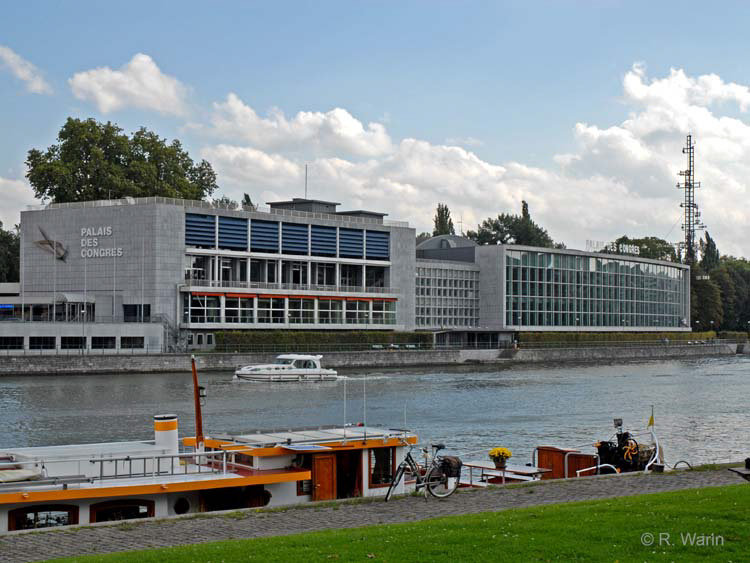
|
| Mineral: | Before the show. |
| Description: |
|
| Viewed: |
20702 Time(s) |
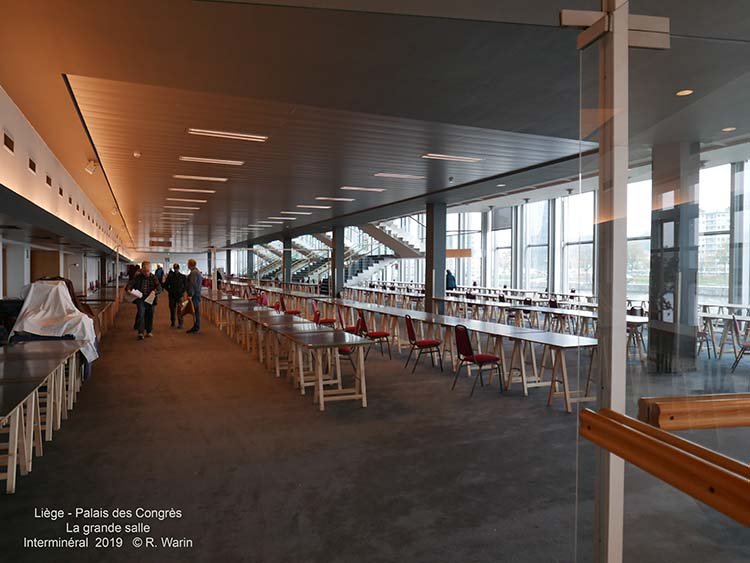
|
| Mineral: | The river Meuse |
| Description: |
|
| Viewed: |
20670 Time(s) |
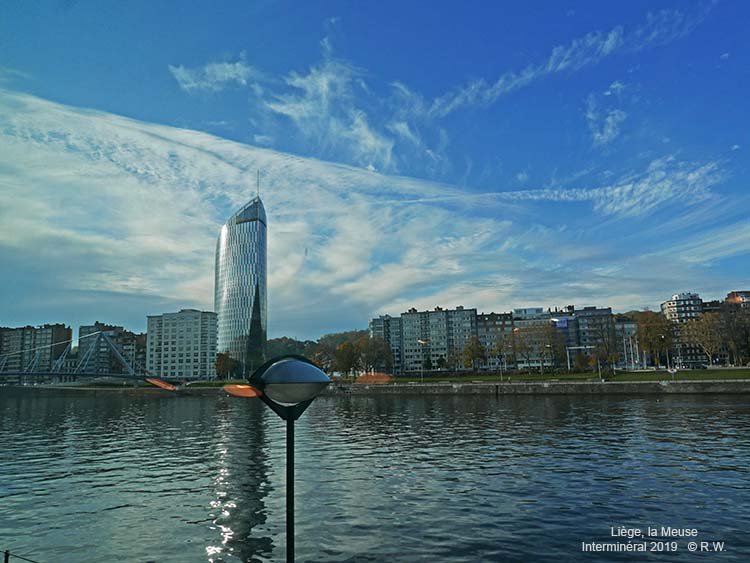
|
| Mineral: | Calcite |
| Locality: | | Elmwood Mine, Carthage, Central Tennessee Ba-F-Pb-Zn District, Smith County, Tennessee, USA |  |
|
| Description: |
|
| Viewed: |
20689 Time(s) |
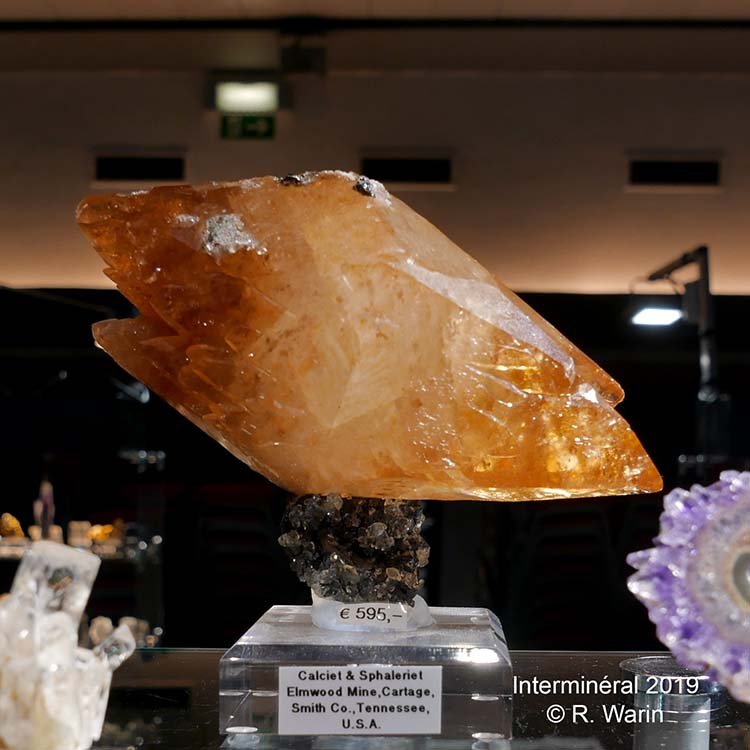
|
| Mineral: | Carrollite |
| Locality: | | Kamoya, Kambove District, Katanga Copper Crescent, Katanga (Shaba), Democratic Republic of the Congo (Zaire) |  |
|
| Description: |
| A nice specimen... for € 40. |
|
| Viewed: |
20662 Time(s) |
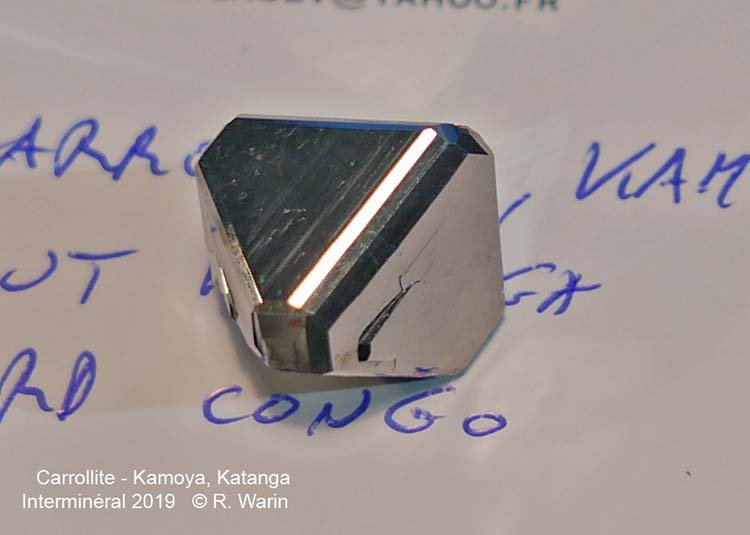
|
| Mineral: | Fluorite |
| Locality: | | La Barre Mine, Saint-Jacques-d'Ambur, Pontgibaud, Saint-Ours, Riom, Puy-de-Dôme Department, Auvergne-Rhône-Alpes, France |  |
|
| Description: |
|
| Viewed: |
20703 Time(s) |
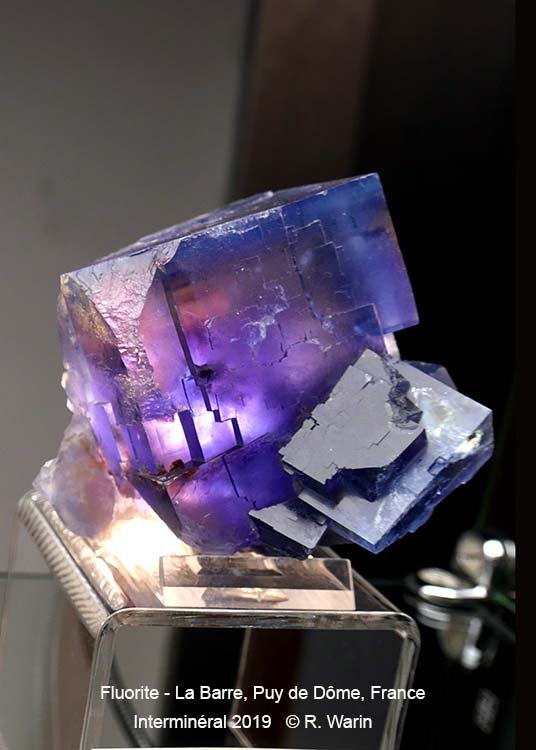
|
| Mineral: | Fluorite |
| Locality: | | Denton Mine, Sub-Rosiclare formation, Goose Creek Mine group, Harris Creek Sub-District, Hardin County, Illinois, USA |  |
|
| Description: |
|
| Viewed: |
20740 Time(s) |
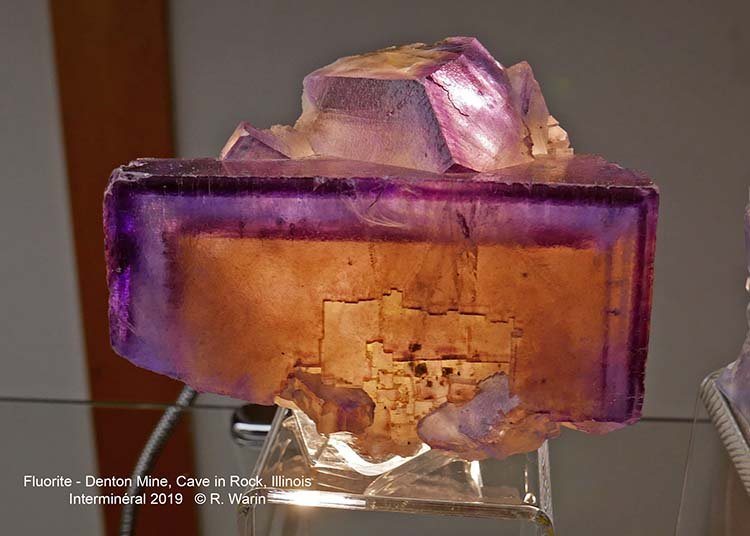
|
|
|
| Back to top |
|
 |
Roger Warin

Joined: 23 Jan 2013
Posts: 1233



|
 Posted: Nov 24, 2019 01:51 Post subject: Re: LIEGE Show (Nov. 2019). Posted: Nov 24, 2019 01:51 Post subject: Re: LIEGE Show (Nov. 2019). |
|
|
and more minerals
| Mineral: | Fluorite |
| Locality: | | Minerva I Mine, Ozark-Mahoning group, Cave-in-Rock Sub-District, Hardin County, Illinois, USA |  |
|
| Description: |
|
| Viewed: |
20547 Time(s) |
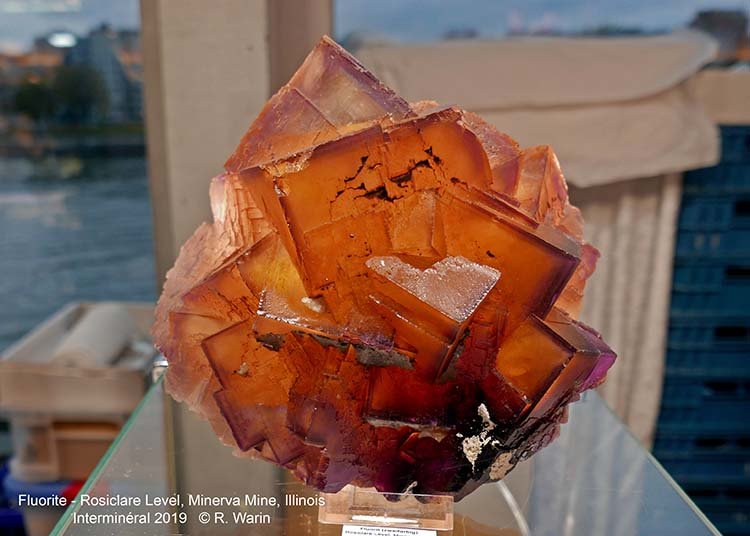
|
| Mineral: | Fluorite |
| Locality: | | Mandronarivo area, Beroroha District, Atsimo-Andrefana Region, Madagascar |  |
|
| Description: |
|
| Viewed: |
20565 Time(s) |
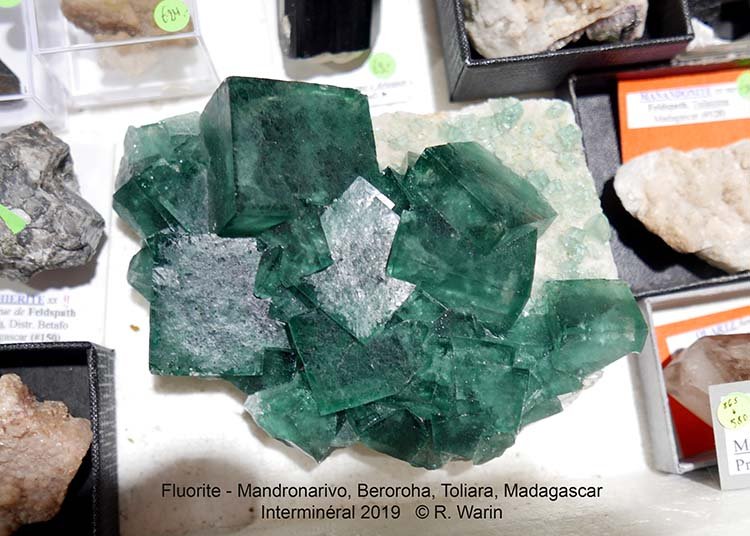
|
| Mineral: | Malachite |
| Locality: | | Mindingi Mine (Mindigi Mine), Swambo, Kambove District, Katanga Copper Crescent, Katanga (Shaba), Democratic Republic of the Congo (Zaire) |  |
|
| Description: |
|
| Viewed: |
20618 Time(s) |
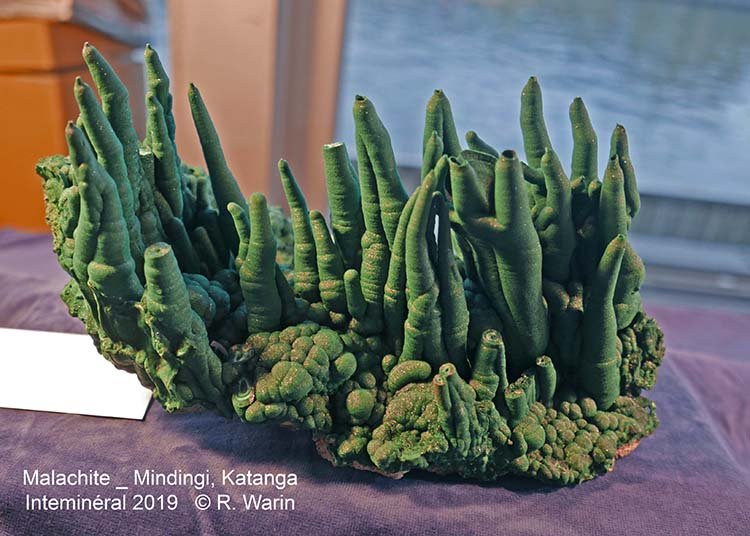
|
| Mineral: | Malachite |
| Locality: | | Katanga (Shaba), Democratic Republic of the Congo (Zaire) |  |
|
| Description: |
|
| Viewed: |
20524 Time(s) |
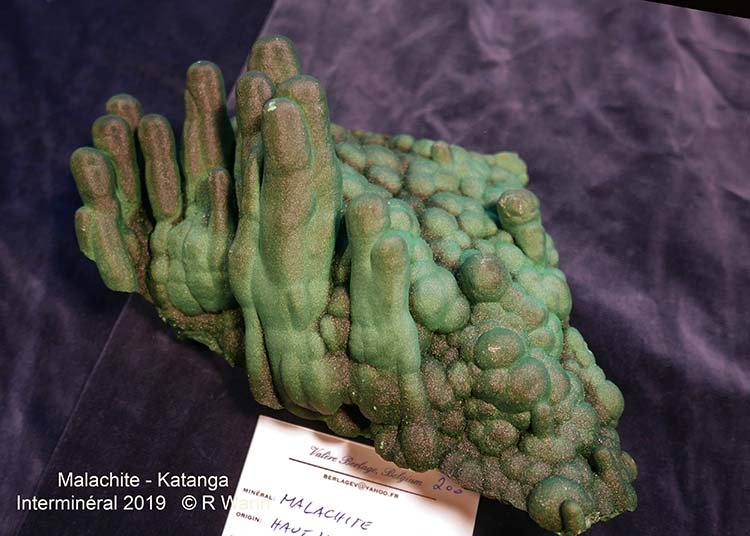
|
| Mineral: | Malachite |
| Locality: | | Mindingi Mine (Mindigi Mine), Swambo, Kambove District, Katanga Copper Crescent, Katanga (Shaba), Democratic Republic of the Congo (Zaire) |  |
|
| Description: |
|
| Viewed: |
20571 Time(s) |
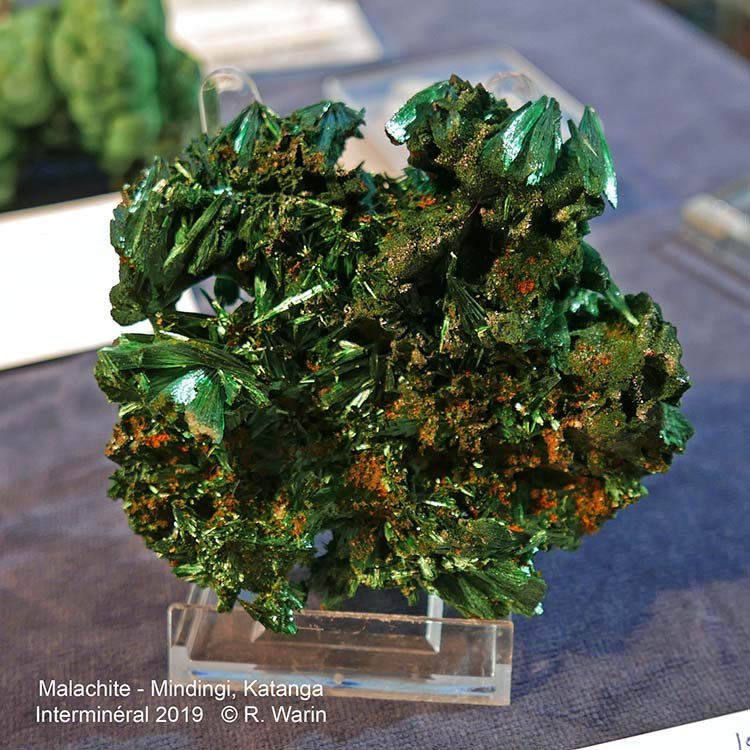
|
|
|
| Back to top |
|
 |
Roger Warin

Joined: 23 Jan 2013
Posts: 1233



|
 Posted: Nov 25, 2019 01:20 Post subject: Re: LIEGE Show (Nov. 2019). Posted: Nov 25, 2019 01:20 Post subject: Re: LIEGE Show (Nov. 2019). |
|
|
Some nice specimens
| Mineral: | Pyrite |
| Locality: | | Elba Island, Livorno Province, Tuscany, Italy |  |
|
| Description: |
The pyrite pyritoèdre is not the regular pentagonal dodecahedron of Plato.
Pyrite of Elba Island is stable.
Price: USD 25. |
|
| Viewed: |
20321 Time(s) |
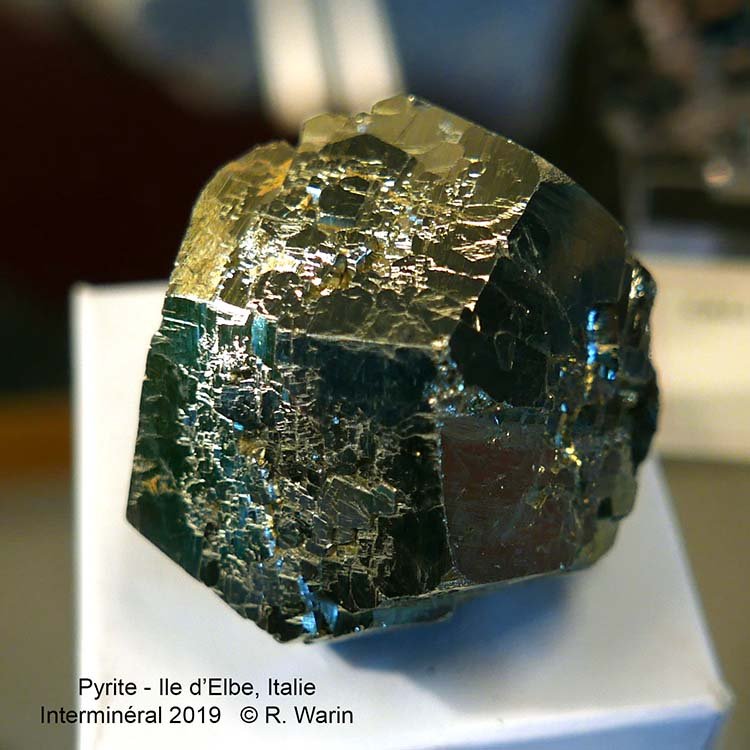
|
| Mineral: | Tourmaline in quartz |
| Locality: | | Governador Valadares, Vale do Rio Doce, Minas Gerais, Brazil |  |
|
| Description: |
|
| Viewed: |
20308 Time(s) |

|
| Mineral: | Shattuckite |
| Locality: | | Tantara Mine, Shinkolobwe, Katanga Copper Crescent, Katanga (Shaba), Democratic Republic of the Congo (Zaire) |  |
|
| Description: |
| Shattuckite is a pyroxene while planchite is an amphibole. |
|
| Viewed: |
20337 Time(s) |
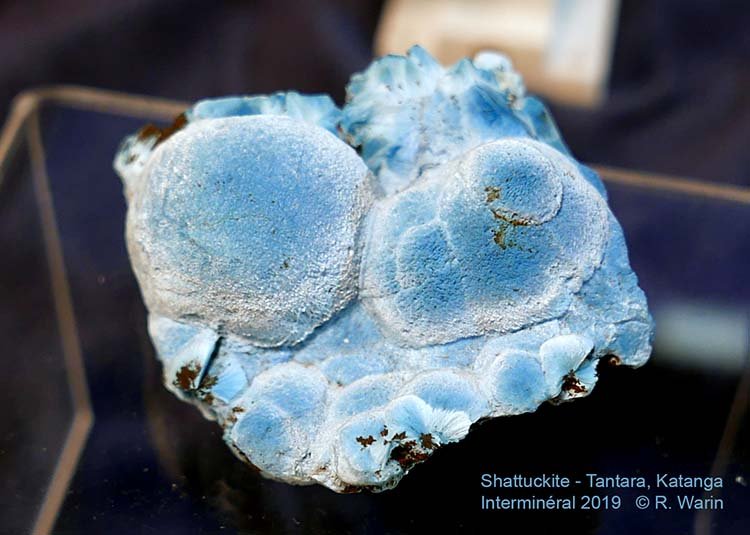
|
|
|
| Back to top |
|
 |
Roger Warin

Joined: 23 Jan 2013
Posts: 1233



|
 Posted: Nov 25, 2019 08:38 Post subject: Re: LIEGE Show (Nov. 2019). Posted: Nov 25, 2019 08:38 Post subject: Re: LIEGE Show (Nov. 2019). |
|
|
Here is the end of my walk, but I reserve you a surprise in our thematic exhibition.
Stilbite, a zeolite: loss of water on heating; reversible process.
Apophyllite, a phyllosilicate: loss of water on heating; irreversible process.
Variscite = aluminum phosphate in cryptocrystalline kidneys.
| Mineral: | Stilbite-Ca |
| Locality: | | Savada, Dharangaon, Jalgaon District, Maharashtra, India |  |
|
| Description: |
| with pseudo-cubic apophyllite |
|
| Viewed: |
20277 Time(s) |
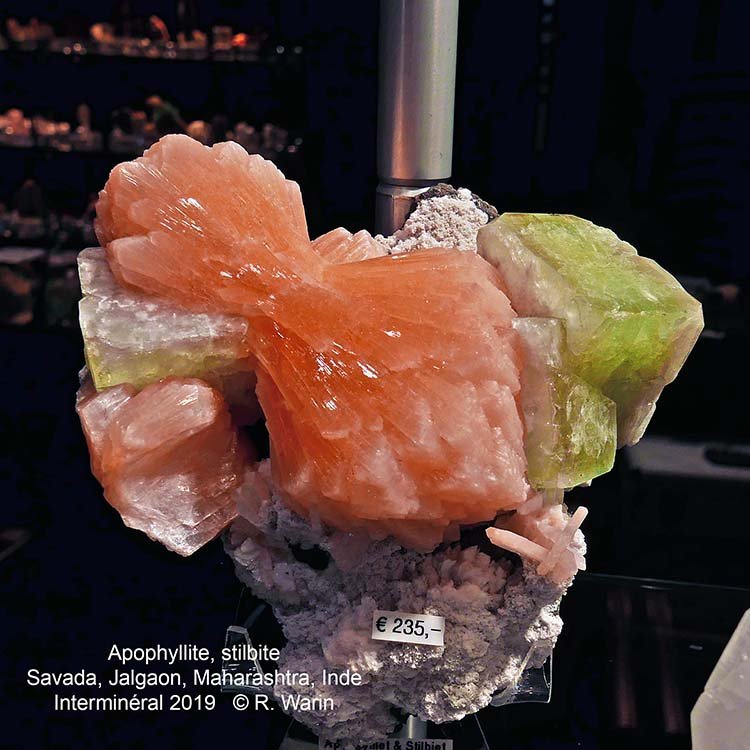
|
| Mineral: | Variscite |
| Locality: | | Little Green Monster Variscite Mine, Clay Canyon, Oquirrh Mountains, Fairfield, Utah County, Utah, USA |  |
|
| Description: |
|
| Viewed: |
20276 Time(s) |
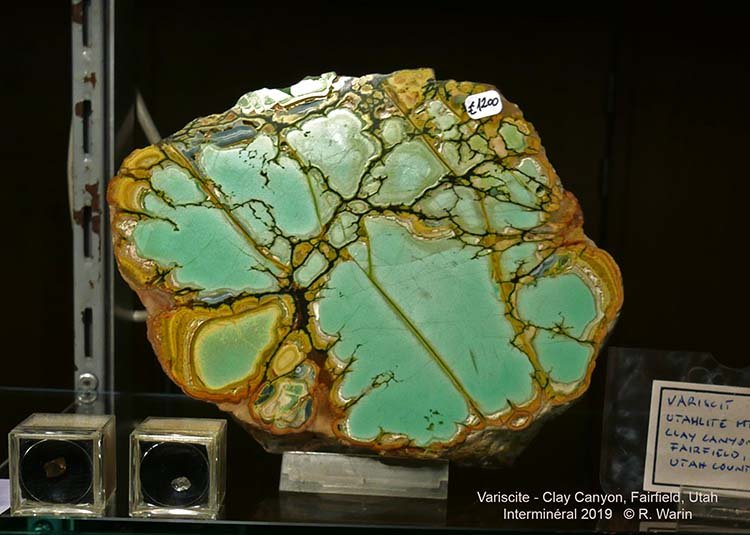
|
|
|
| Back to top |
|
 |
Roger Warin

Joined: 23 Jan 2013
Posts: 1233



|
 Posted: Nov 25, 2019 16:26 Post subject: Re: LIEGE Show (Nov. 2019). Posted: Nov 25, 2019 16:26 Post subject: Re: LIEGE Show (Nov. 2019). |
|
|
25 11 2019
Hi,
In the Liege Mineral Show, there is always a thematic exhibition on a theme close to minerals or fossils. So in the past, Dr. Simon Philippo (MNHNLux - curator of the Luxembourg Museum) and Professor Frederic Hatert ULiege (Cesàro Museum in Liège) have already participated in this thematic exhibition of prestige.
In November 2019, we presented the very large private collection of prehistoric, protohistoric and historic artefacts of Mr. Daniel Moyano, Ing.
This collection was collected by an eclectic farmer living in St-Georges (in Hesbaye, in the suburbs of Liège) who searched his land between 1934 and 1985 in search of prehistoric objects.
He accumulated and published many remarkable specimens. We had already shown the public part of this collection in 2012.
In 2019 we took up this theme by adding a unique "stone" discovered by Joseph Destexhe, an intaglio found in Velroux, on a site where the Liege airport is now built.
This intaglio is more than remarkable because it represents Octavian, the future Roman Emperor who took the name of Auguste (63 BC-14 AD).
The intaglio analyzes were carried out at the University of Liège - F. Hatert, one of whose specialties is the analysis of ancient gemstones and at the Basel Gemmology Laboratory in Switzerland (Schweizerisches Gemmologisches Institut) that this intaglio was carved from an quartz, ametrine variety.
Various techniques have been used including Raman spectrometry, X-ray fluorescence and Gem TOF (laser ablation-mass spectrometry).
The composition of the stone is important, because it is thus the authors have found the trace of the origin of this ametrine. Ametrine is the continuous association of amethyst (purple) and citrine (yellow), two varieties of quartz.
In Roman times, however, there was only one known ametrine deposit. It was located in Andhra Pradesh province in Hyperabad (India).
It is now certain that this intaglio belonged to a high dignitary of the Roman Empire. It was lost in a bathroom of a Roman villa of 3 ha, the stone was detached from the ring.
This intaglio is extremely rare and seems to be one of the beautiful of the Roman world. It will be sold at Christie's. Its value is estimated at USD 350,000.
Daniel Moyano have published in AGAB-Minibul Bulletin a descriptive article of which I can send you the pdf (in French).
Designed to be set on a ring, Octave's intaglio is small: 18 mm long, 15 mm wide, 5.5 mm thick and its mass = 2.23 g.
I had the pleasure of photographing this intaglio in macro but also under the microscope to highlight the art of the Greek lapidaries who worked in Rome. Octave's intaglio was cut between 40 - 30 BP. These artisans-artists were few, 3 or 4. The question that arose "how were they doing?". If the rotating milling technique was known (with diamond powder - Ragimov 2014), how could they see and carve such small objects? Did they know the magnifying glass? What do you think about?
In fact, it is likely that these artists were very myopic and looked very closely.
I photographed this intaglio from different angles to highlight its features. It is not easy to photograph an intaglio placed vertically under a microscope. I obviously used the stacking technique.
From the front, in incident light, we do not see many inclusions in the stone. By transparency, the microscope shows more inclusions and other aspects. By transparency, we distinguish the zebra stripes. These are ripples of optical origin typical of amethyst.
The transition between amethyst and citrine areas is not clear. The transition is continuous. However, viewed from the side, the transition is sharper. From the front it was averaged by stacking.
Comments
1) Ametrine cut.
2) Intaglio representing Octave, future emperor Augustus.
3) Detail of the neck in ametrine.
4) Comparison between Octave (Intaglio) and bust of Augustus, at the Topkapi Museum, Turkey.
5) Details of the hair, with some shade of citrine.
6) Detail of the eye.
7) Profile view of the intaglio - eye, zebra prints, citrine areas (5.5 mm thick).
| Mineral: | Ametrine |
| Description: |
|
| Viewed: |
20154 Time(s) |
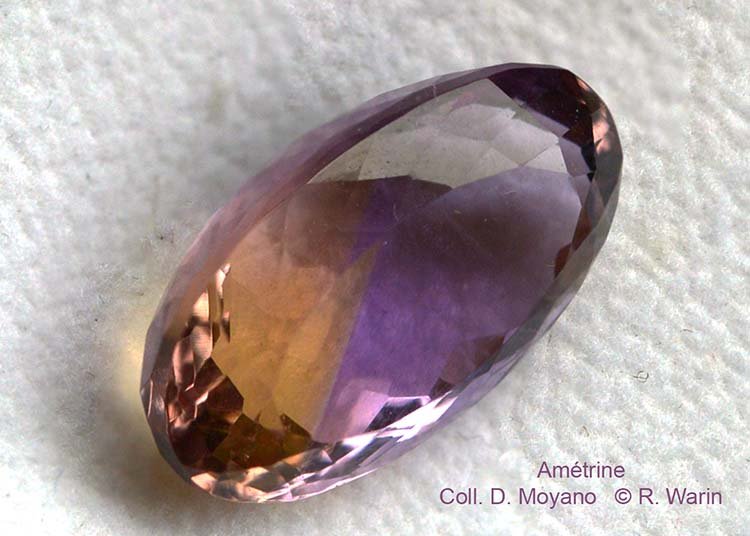
|
| Mineral: | Ametrine ! |
| Description: |
| 2) Intaglio representing Octave, future emperor Augustus. |
|
| Viewed: |
20149 Time(s) |
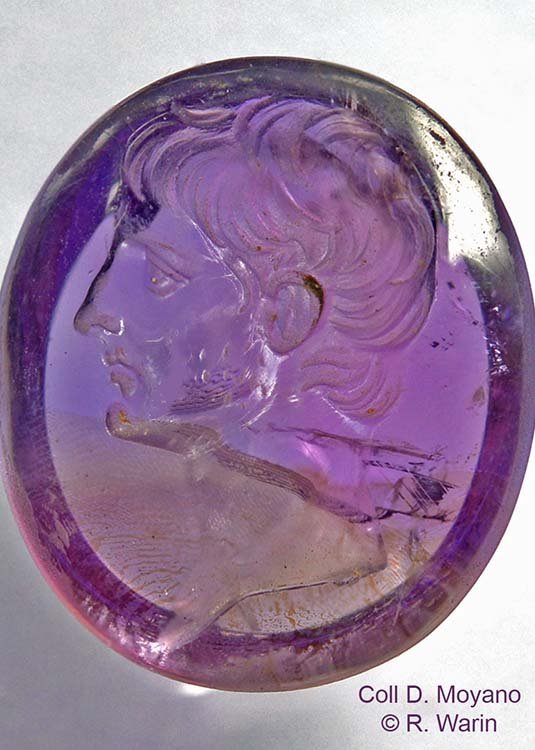
|
| Description: |
| 3) Detail of the neck in ametrine. |
|
| Viewed: |
20145 Time(s) |
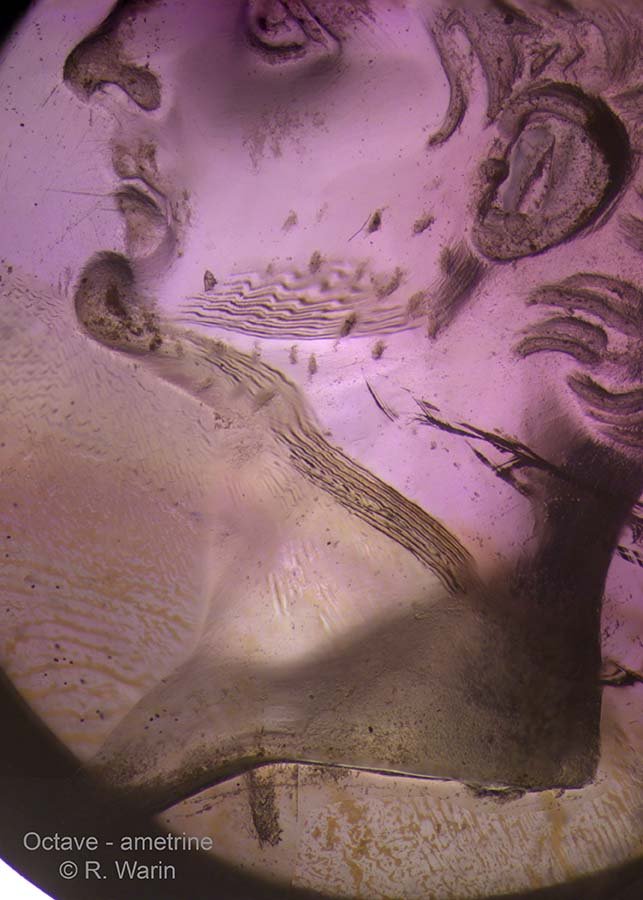
|
| Description: |
| 4) Comparison between Octave (Intaglio) and bust of Augustus, at the Topkapi Museum, Turkey. |
|
| Viewed: |
20154 Time(s) |
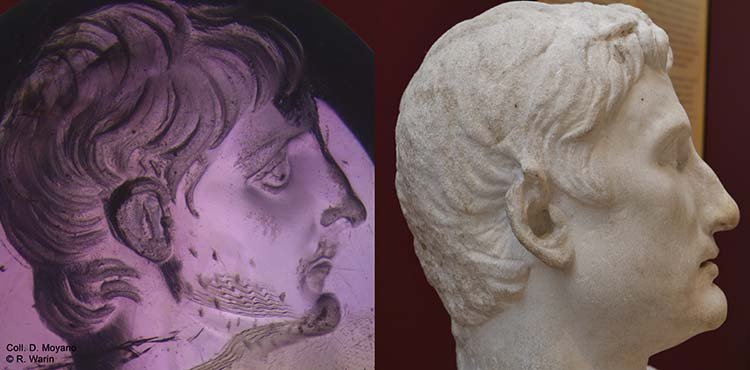
|
| Description: |
|
| Viewed: |
20143 Time(s) |
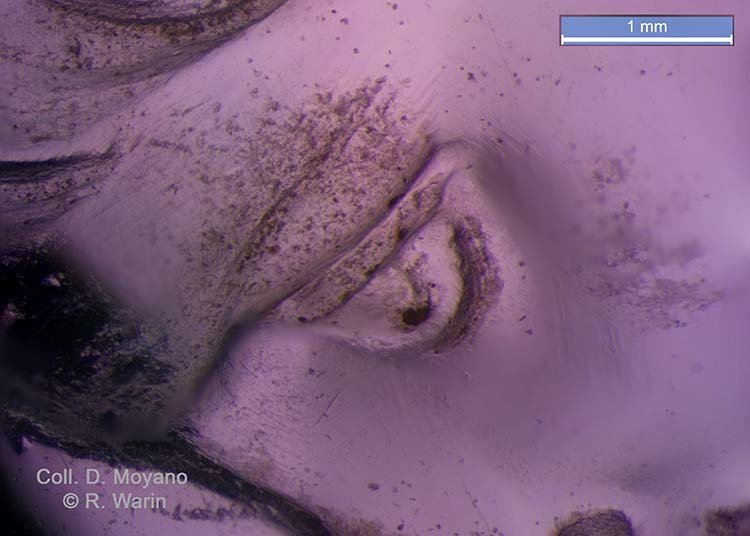
|
| Description: |
| 7) Profile view of the intaglio - eye, zebra prints, citrine areas (5.5 mm thick). |
|
| Viewed: |
20144 Time(s) |
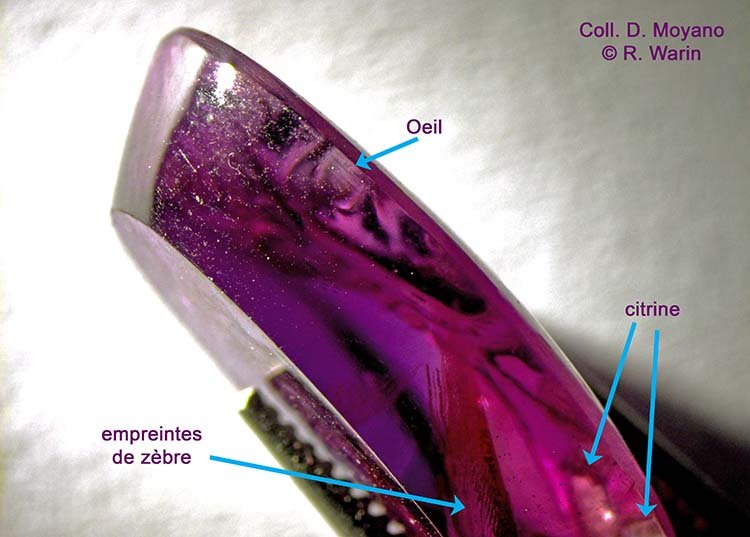
|
| Description: |
| 5) Details of the hair, with some shade of citrine. |
|
| Viewed: |
20136 Time(s) |
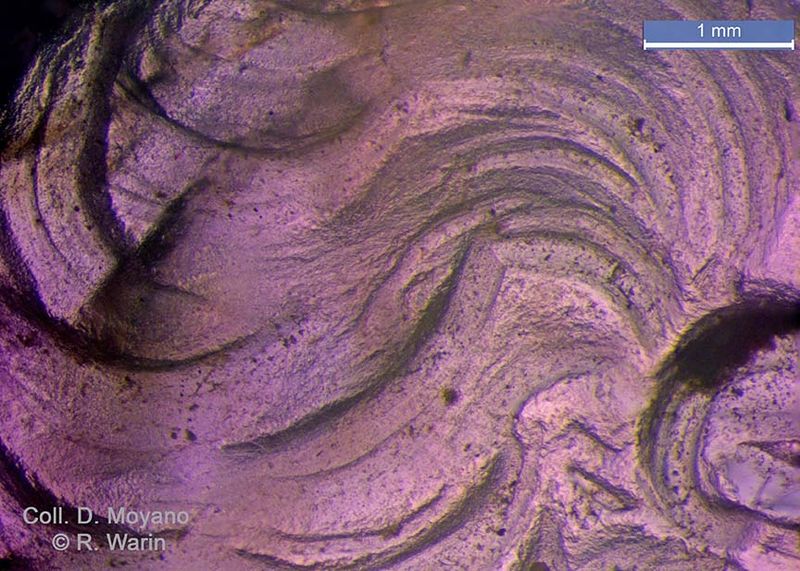
|
|
|
| Back to top |
|
 |
|





